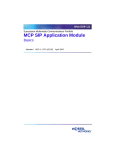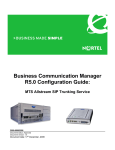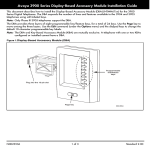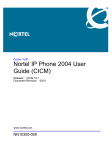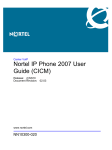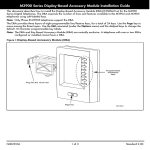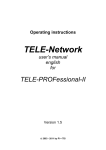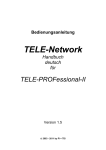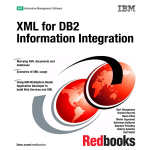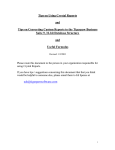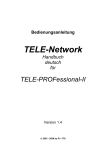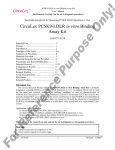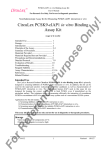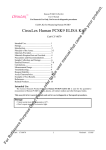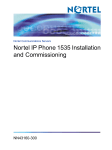Download Nortel Networks Telephone NN10033-111 User's Manual
Transcript
NN10033-111 Succession Multimedia Communications Portfolio MCP Interworking Basics Standard MCP 1.1 FP1 (02.02) April 2003 Nortel Networks Confidential 3 Overview How is this chapter organized This chapter provides a high-level overview of the interworking between the Multimedia Communications Platform (MCP) and the following systems: • Primary Rate Interface (PRI)-enabled switches • SIP-T-based switches • third-party gateways • traditional phones • third-party voicemail servers Interworking with PRI-enabled switches The MCP uses the SIP PRI Gateway to perform interworking with PRI-enabled switches (switches with PRI interfaces). For more detailed information about the SIP PRI Gateway, please refer to the MCP SIP PRI Gateway Basics document. Functional description The SIP PRI Gateway is a signaling and media gateway that interconnects a SIP-based Voice over IP (VoIP) domain and a system that uses ISDN Primary Rate Interface (PRI/Q.931). A PRI-enabled system can be a switch that works on the Public-Switched Telephone Network (PSTN) or Private Branch Exchange (PBX). The Nortel Networks DMS-100 and the Nortel Networks Meridian SL-100 are examples of PRI-enabled switches. The SIP PRI Gateway’s primary function is to convert the packet-based voice streams of the VoIP system to circuit-based voice streams of the PRI-enabled system. Copyright © 2003, Nortel Networks MCP Interworking Basics Nortel Networks Confidential 4 Overview Supported services The SIP PRI Gateway supports the following call types: • SIP to PRI • PRI to SIP • PRI to PRI The SIP PRI Gateway supports the following call features: • Basic call: The ability to make a call. • Hold/Retrieve: The ability to hold and retrieve calls. • Call transfers: The ability to forward the call to a third party after the call is established. Call transfer is limited to SIP clients. Callers from the PRI-enabled switches cannot perform this function. • Call redirect: The ability to forward a call before it is answered. • Codec negotiation: The ability to negotiate between different VoIP codecs during call setup, mid-call, call transfer, and call retrieve. The SIP PRI Gateway supports the following codecs: — G.711 mu-law (PCMU) — G.711 a-law (PCMA) — G.723.1 — G.729a • Call rejection: The ability to reject a call on nodal authentication request. • Calling party name and number: The MCP supports the delivery/reception of calling party name and number information to/from PRI-enabled switches. Incoming calling party information privacy indication is honored by the MCP. For MCP call originations, privacy indication is not used. • Dual-Tone Multi Frequency (DTMF) outpulsing: The ability to outpulse to PRI-enabled switches. However, DTMF detection is not provided. Military DTMF digits A-D are currently not supported. • ISDN trunk group selection: The selection is based on information provided in a request Universal Resource Identifier (URI). • Ringback: The SIP PRI Gateway provides ringback towards the circuit-switched side of the network. • PRI variant support: The SIP PRI Gateway supports different PRI variants. For a list of the PRI variants that the SIP PRI Gateway supports, please refer to the MCP SIP PRI Gateway Basics document. NN10033-111 Standard MCP 1.1 FP1 (02.02) April 2003 Copyright © 2003, Nortel Networks Nortel Networks Confidential • Overview 5 SIP/PRI mapping support, including: — Protocol parameter mapping — error codes — PRI cause values with SIP responses — presentation and screening indicators • PRACK: the provisional response acknowledge message that ensures that the ringing signal does not get lost. • Type of Server (ToS): The ToS bit can be configured to indicate the priority of the voice packet over data packet to ensure quality of service. • Long-call service: The ability to detect abandoned calls. More detailed information about the functional capabilities of the SIP PRI Gateway is available in the MCP SIP PRI Gateway Basics document. Interworking with CS 2000 Even though Nortel Networks Communication Server 2000 (CS 2000) is a VoIP switch, it does not fully support the Session Initiation Protocol (SIP). The following description provides information on how the MCP interworks with the CS 2000. The MCP does not support VoIP over Asynchronous Transfer Mode (ATM) or pure ATM, as the MCP network nodes are IP-based and not ATM based. Functional description The interworking between an MCP and CS 2000 uses Session Initiation Protocol for Telephones (SIP-T) over User Datagram Protocol (UDP) to transport ISDN User Part (ISUP), the call control part of the Signaling System 7 (SS7) protocol. SIP-T is an extension of the Session Initiation Protocol (SIP) that allows SIP to be used to facilitate the interconnection of the Public Switched Telephone Network (PSTN) with packet networks. SIP-T encapsulates the ISDN User Part (ISUP) messages in the SIP messages and translates ISUP information into the SIP header for routing purposes. Although the MCP SIP Application Module supports receiving of encapsulated ISUP messaging (using SIP-T), it does not send encapsulated ISUP back out. For more information about the capabilities of the SIP Application Module, please refer to the SIP Application Module Basics document. Copyright © 2003, Nortel Networks MCP Interworking Basics Nortel Networks Confidential 6 Overview Figure 1 shows a network view of the MCP/CS 2000 interconnection. The MCP configuration enables direct connection between the MCP and CS 2000 with no intervening SIP proxies. The CS 2000 and its associated media gateways are placed in the private managed network. Figure 1 MCP/CS 2000 Network view PSTN network 1 PSTN network 2 SIP-T SIP-T SIP SIP-T SIP SIP MCP network 1 MCP network 2 Supported services This section provides information on services that can interwork between the two platforms. VPN Dialing A Virtual Private Network (VPN) dial plan enables an enterprise to have one common dial plan across different geographic locations without incurring long-distance expenses. The MCP system uses domains to manage its call routing, while the CS 2000 system uses customer groups. A profile is used to facilitate call routing between the two systems. The header named “x-nortel-profile” is used to identify the CS 2000 profile. The profile is used to map the domain to a PSTN customer group in the PRODOMAIN table in the Database Module. NN10033-111 Standard MCP 1.1 FP1 (02.02) April 2003 Copyright © 2003, Nortel Networks Nortel Networks Confidential Overview 7 The profile is added when a new domain is created in the MCP system. Note: The profile name in the TELEPROF table on the CS 2000 side must match the profile name in the PRODOMAIN table on the MCP side. Otherwise, interworking between the MCP and CS 2000 will not work. Call Forward Both the MCP and the CS 2000 support call forwarding. No extra interworking considerations are necessary as call forwarding does not interact across the MCP and CS 2000 domains, except to deliver a call between the two domains. Call Transfer Call transfer works between the two platforms. The calls are transferred because from each platforms view the other is just initiating a new call. Ad Hoc Conference calls There is no change in the conference application between the two platforms. When an ad hoc conference call is made, the client application that starts the conference controls where the conference bridge is allocated. For example, if the conference call is made from a client application on the MCP side, the conference bridge will be allocated on the MCP. Media Negotiation The MCP provides media negotiation for the CS 2000 since the CS 2000 gateway controller is not capable of providing this function in the current release. The MCP requires a list of all commonly supported codecs across the CS 2000 media gateways to be provisioned in the cs2k.xml file. The list is required because the MCP does not determine which gateway the CS 2000 will use. Although the MCP also allows for the provisioning of packet times that the CS 2000 will use, this is not recommended. By provisioning specific packet times, the SDP packet time will no longer pass transparently through the MCP. This means that the packet time negotiation that would normally occur at the client level is now being handled at the server level, and this could lead to voice connection issues. The SDP sent by the CS 2000 media gateways is only guaranteed to contain the v=, c=, m=, and a= SDP headers in the SDP message. The gateways can accept reception of other SDP parameters, so no screening needs to be done on the SDP that the MCP sends to the CS 2000. The only exception is the screening of the m= lines to only Copyright © 2003, Nortel Networks MCP Interworking Basics Nortel Networks Confidential 8 Overview include the audio codecs supported by the gateways. For the SDP that is received from the CS 2000, the MCP fills in the missing mandatory parameters as specified in RFC 2327. Details on the restrictions on SDP are specified in the SN03 IP Gateway InterOP Requirements document. Recursive Search The MCP Back-to-Back User Agent (BBUA) handles SIP 302 responses to an INVITE sent out because of a received INVITE from the CS 2000. The BBUA sends INVITEs for each contact in the SIP 302 response. The SIP 302 response will not be passed back to the CS 2000. The INVITES for each contact can be sent parallel or sequentially depending on the mode in which the BBUA processed the initial INVITE, which then resulted in the SIP 302 response. Hold SIP implements a Hold as a re-INVITE with the connection information in the SDP set to 0.0.0.0. In this release, Hold cannot be handled by all the CS 2000 media gateways. The MCP shields the CS 2000 from seeing Hold re-INVITE requests. The MCP, when equipped with an RTP Media Portal, can manage the RTP connections without affecting the connection to the CS 2000. Retrieve Retrieve is also implemented in SIP through a re-invite. To retrieve a party on hold the new invite contains valid SDP. The new SDP is used to restore the media connection between the two clients. Long Call Audit Timers In order to prevent hung calls between the two platforms, a long call audit timer is implemented between the two platforms. Both platforms use the INFO ping capability described in the SIP INFO message RFC2976. This involves sending an INFO message with no message body. Upon receipt of this message, a client should send a 200 OK if the call exists. If the response to the INFO is any of the following response codes, then the platform sending the message assumes that the call no longer exists and frees all resources associated with the call: • 404 Not Found • 408 Request Timeout • 410 Gone • 480 Temporarily Unavailable • 481 Transaction Does Not Exist NN10033-111 Standard MCP 1.1 FP1 (02.02) April 2003 Copyright © 2003, Nortel Networks Nortel Networks Confidential Overview 9 If the platform sending the INFO receives a response code other than the ones listed above, it treats the response as a valid audit response, and does not bring the call down. The CS 2000 sends a 200 OK for an empty INFO message and a 481 response code if the call leg does not exist. Supported media The following are the media supported by the interworking of MCP and the CS 2000: • G. 711 PCMU • G. 711 PCMA • G. 729 • G. 723 • G3 Fax • Modem Note 1: This list represents a full list of the media capabilities the MCP can use while interworking with the CS 2000. The actual list of supported media types depends on the capabilities of the gateways that the CS 2000 is using. Note 2: G3 Fax and Modem media calls are used only for CS 2000 gateway calls as there are no MCP endpoints that support either of these two media types. QoS MCP implements its Quality of Service through the DiffServ (Differentiated Service) feature. The parameters of MCP QoS include the following: • QoS DiffServ code for signaling: specifies signaling quality for SIP clients. • QoS DiffServ code for audio: specifies audio quality for SIP clients. • QoS DiffServ code for video: specifies video quality for SIP clients. • QoS 802.1p for service priority: specifies service priority for SIP clients. Interworking with third-party gateways The MCP can use SIP signaling between the MCP network and a third-party SIP-enabled gateway. The third-party gateway provides the necessary signalling interworking between the MCP network and the other network to which the gateway is connected. For example, a Copyright © 2003, Nortel Networks MCP Interworking Basics Nortel Networks Confidential 10 Overview line-based voicemail server requires that a Line Gateway be placed between the MCP network and the voicemail server. This Line Gateway would process SIP messages to/from the MCP network and create the corresponding line signalling to/from the line network. “Interworking with third-party voicemail servers” on page 13, provides more information about how the MCP interworks with non-SIP aware voicemail servers. Interworking with traditional phones The MCP provides Converged Desktop Services (CDS) to facilitate the interworking with traditional phones of the TDM network. This allows users to have a personal computer (PC) provide the multimedia portion of their communication session while having the traditional telephony system provide the voice portion of their communication session. Functional description A user’s Converged Desktop consists of a regular TDM telephone, and a SIP Multimedia PC Client (PC Client) software provisioned as a Converged PC Client. Figure 2 shows how the Converged PC Client interconnects with the network. The Converged PC Client provides an enhanced communication experience to the user, while the TDM telephone works exactly as it does today. Figure 2 Converged Desktop Services Network Diagram MCP network PRI Existing switching system Various line protocols SIP Converged Desktop Converged PC Client NN10033-111 Standard MCP 1.1 FP1 (02.02) April 2003 Traditional phone Copyright © 2003, Nortel Networks Nortel Networks Confidential Overview 11 Converged Desktop Services CDS enhances the end user’s communication experience in a variety of ways: • Advanced Call Handling: The user can use the MCP Personal Agent web pages to control the user’s availability. By providing this ability to CDS users, features not easily accessible on existing TDM switching systems now become viable. For example, a user can activate MCP-based forking (using the Personal Agent web pages) so that when the user’s desktop telephone is called, the users cell phone rings as well. Once one leg of the forked call is answered, the other leg stops ringing. • Inbound call log: Allows the user to see who has called and when the call occurred. • Video calling line identification: Allows the user to see who is calling. The picture is retrieved from the network-based address book accessible on the Converged PC Client. • Redirection of incoming calls at the Converged PC Client: Upon the arrival of an incoming call, the user may click on the “Redirect” button, and send the incoming call to another address. Once the user answers the call (using the TDM phone), the redirect function is no longer available. • File transfer: If both the originator and terminator support the MCP file transfer collaboration application, then files can be transferred back and forth between the two users. The PC Client (both Converged and non-Converged) is the only endpoint that supports this functionality. • Whiteboard sharing: If both the originator and terminator support the MCP whiteboard collaboration application, then a whiteboard session can be set up between the two users. The PC Client (both Converged and non-Converged) is the only endpoint that supports this functionality. • Clipboard transfer: If both the originator and terminator support the MCP clipboard transfer collaboration application, then the Windows System Clipboard may be transferred between the two users. The clipboard transfer application allows a user to “Copy (CTRL-C)” items such as PowerPoint slides or sections of Excel spreadsheets to the clipboard, and then sends them to the other party. The other party then “Pastes (CTRL-V)” the items. The PC Client (both Converged and non-Converged) is the only endpoint that supports this functionality. • Web Co-browsing: If both the originator and terminator are capable of this functionality, then one user can automatically drive the other’s web browser. The PC Client (both Converged and Copyright © 2003, Nortel Networks MCP Interworking Basics Nortel Networks Confidential 12 Overview non-Converged) is the only endpoint that supports this functionality. The Web Client supports the reception of web pages, but cannot send web pages to a Converged PC Client. • Instant Messaging (IM): The Converged PC Client can send and receive messages from any client that supports the Nortel Networks IM format. All MCP clients support sending and receiving of instant messages with each other. • Presence state indications: The Converged PC Client allows the user to select a presence state in the MCP network. The Converged PC Client also allows the user to see the presence states for the Buddies defined in the user’s network-based address book. Configuration Requirements PRI is used as the interface between the existing TDM switching system and the MCP. The MCP supports the following PRI protocol variants: • AT&T 4ESS(AT4) • AT&T 5ESS (E10) • AT&T TR 41459 • Bellcore National 2 • ETSI • ECMA-143 • ETS 300 102-1 • Northern Telecom DMS-100 (DMS) • NIS A211-1 • QSig For more detailed information about the which PRI variants the SIP PRI Gateway supports, please refer to the MCP SIP PRI Gateway Basics document. Successful interworking between the MCP and the TDM switch requires that the TDM switch activate the Simultaneous Ring (SimRing) feature and assign each user a SimRing number. A user in the TDM switch that has acquired this SimRing number can be a CDS user. The SimRing feature must send “SimRing” calls to a routable and unique number for each CDS user. The MCP system operator must provision a user as a CDS user. A CDS user cannot use the SIP Multimedia PC Client for voice. The CDS user’s TDM phone is used for voice. In addition, the CDS user may use NN10033-111 Standard MCP 1.1 FP1 (02.02) April 2003 Copyright © 2003, Nortel Networks Nortel Networks Confidential Overview 13 other SIP endpoints (such as the SIP Multimedia Web Client or an i2004 controlled by the IP Client Manager (IPCM) for voice over IP calls. An MCP alias must be set up for each user so that the alias is the same as the Calling Line ID sent from the TDM switch to the MCP over PRI. When a non-CDS MCP user calls a CDS user, the call is sent out the gateway to the CDS user’s TDM phone and the non-CDS user’s public/private charge ID is used to identify them to the TDM switch as the calling party. This charge ID is sent to the Converged PC Client, on the SimRing leg of the call, and is used by the Converged PC Client to contact the calling party’s MCP client. Therefore, the non-CDS user’s charge ID must be included as an alias in the non-CDS user’s provisioning. A non-CDS user’s charge ID cannot be shared amongst users within a domain because the charge ID must be included as an alias and a user's aliases must be unique within a domain. Calls to a CDS user must terminate to the existing switching system of the CDS user before the call is routed to the MCP. For example, the originator’s existing switching system must route calls using the existing systems, as opposed to sending the call to the MCP. This is required since all calls from the SIP PRI gateway are implied to have been triggered by the SimRing feature on the existing switching system. Interworking with third-party voicemail servers There are three major types of third-party voicemail servers. The following sections describe how the MCP can interwork with the following types of third-party voicemail servers: • SIP-based voicemail servers • Trunk-based voicemail servers • Line-based voicemail servers SIP-based voicemail servers SIP-based voicemail servers are SIP-enabled and can interwork directly with the MCP network. SIP is used to set up connections between the client and the voicemail server. The RTP Media Portal is used to carry the media packets between the client and the voicemail server. Figure 3 shows how the MCP interconnects with a SIP-aware third-party voicemail server. Copyright © 2003, Nortel Networks MCP Interworking Basics Nortel Networks Confidential 14 Overview Figure 3 SIP-based Voicemail Server MCP network UNIStim SIP MGCP+ RTP RTP For more information on how the SIP Application Module uses Media Gateway Control Protocol Plus (MGCP+) to control the RTP Media Portal, please refer to the MCP Media Portal Basics document. For more information on how the IP Client Manager uses Unified Networks IP Stimulus (UNIStim) to control the i2004 Internet Telephone, please refer to the MCP IP Client Manager Basics document. Trunk-based voicemail servers Trunk-based voicemail servers cannot directly communicate with the MCP network. A SIP PRI Gateway is required for the MCP to interwork with a trunk-based voicemail server. The SIP PRI Gateway also provides a media path from the IP network to the voicemail server on the PSTN. A terminal server, using a Simplified Message Desktop Interface (SMDI), sends data regarding the storage and retrieval of voicemail from the trunk-based voicemail server to the MCP network. The MCP network does not send data back to the voicemail server over the SMDI link. Figure 4 shows a network view of the MCP interconnection with a trunk-based third-party voicemail server. NN10033-111 Standard MCP 1.1 FP1 (02.02) April 2003 Copyright © 2003, Nortel Networks Nortel Networks Confidential Overview 15 Figure 4 Trunk-based Voicemail Server IP network SMDI SMDI MCP network SIP SMDI PRI UNIStim MGCP+ RTP RTP Line-based voicemail servers Line-based voicemail servers cannot directly communicate with the MCP network. A Line Gateway, also known as an analog station gateway, is required for the MCP to interwork with a line-based voicemail server. Similar to interworking with trunk-based voicemail servers, an SMDI terminal server is to exchange data between the MCP and the legacy voicemail server. However, the SMDI links are used to both send and receive data regarding the storage and retrieval of voicemail from the line-based voicemail server to the MCP network. Figure 5 shows a network view of the MCP interconnection with a line-based third-party voicemail server. Copyright © 2003, Nortel Networks MCP Interworking Basics Nortel Networks Confidential 16 Overview Figure 5 Line-based Voicemail Server IP network SMDI SMDI MCP network SIP SMDI UNIStim MGCP+ RTP RTP NN10033-111 Standard MCP 1.1 FP1 (02.02) April 2003 Copyright © 2003, Nortel Networks Nortel Networks Confidential 17 Upgrades How this chapter is organized This chapter provides information about upgrade procedures dealing with MCP interworking with the following other systems: • Primary Rate Interface (PRI)-enabled switches • SIP-T-based switches • third-party gateways • traditional phones • third-party voicemail servers Interworking with PRI-enabled switches MCP interworking with PRI-enabled switches does not involve additional software deployment to the PRI-enabled switches. The MCP SIP PRI Gateway uses standard PRI protocols and is compatible with any PRI-enabled switch that understands these standard PRI protocols: • AT&T 4ESS(AT4) • AT&T 5ESS (E10) • AT&T TR 41459 • Bellcore National 2 • ETSI • ECMA-143 • ETS 300 102-1 • Northern Telecom DMS-100 (DMS) • NIS A211-1 • QSig Because SIP revisions are backwards compatible, the MCP SIP Application Module and the MCP SIP-PRI Gateway can be upgraded Copyright © 2003, Nortel Networks MCP Interworking Basics Nortel Networks Confidential 18 Upgrades independently of one another. Refer to MCP SIP PRI Gateway Basics and MCP SIP Application Module Basics for more information on upgrades to those nodes of the MCP network. Interworking with CS 2000 MCP interworking with the CS 2000 does not involve additional software deployment. The functionality exists in the SIP Application Module. Refer to the MCP SIP Application Module Basics for more information on upgrades. Note: Since the MCP and CS 2000 can be upgraded at different times, the two products are backwards compatible by one release. Interworking with third-party gateways MCP interworking with SIP-enabled third-party gateways does not involve additional software deployment to the third-party gateways. The MCP SIP Application Module uses SIP to successfully communicate with a third-party gateway that also speaks SIP. Each third-party gateway software release must be validated and certified against the current MCP release. The MCP SIP Application Module and third-party gateways can be upgraded independently of one another. Refer to MCP SIP Application Module Basics for more information on upgrades to the MCP SIP Application Module. For information about the upgrade procedures of a specific third-party vendor’s gateway, please refer to the documentation provided by that third-party vendor. Interworking with Traditional Phones MCP interworking with traditional telephones does not involve additional software deployment to the existing switching system. However, the SimRing feature on the TDM switch must be activated in order to route calls to CDS users. The MCP network and SIP Multimedia PC Client (PC Client) may not be upgraded at the same time. As new CDS functionality is introduced in the network through MCP network node upgrades, the existing PC Clients must continue to interwork with the network. Therefore, the MCP network nodes must be backwards compatible with older PC Clients and MCP nodes. In addition, PC Clients (both Converged and non-Converged) must be backwards compatible with all previously released PC Clients, as different versions of the clients may co-exist in a given MCP network. NN10033-111 Standard MCP 1.1 FP1 (02.02) April 2003 Copyright © 2003, Nortel Networks Nortel Networks Confidential Upgrades 19 Compatibility is maintained by version identifiers included in an MCP user’s service package information. When new CDS functionality becomes available in the MCP network, older Converged PC Clients can continue to exist and operate in the upgraded MCP network; however, they won’t be able to access the new Converged PC Client services. Note: In general, MCP network is upgraded before the PC Client is upgraded. Interworking with third-party voicemail servers MCP interworking with third-party voicemail servers does not involve additional software deployment to the third-party voicemail servers. The MCP SIP Application Module uses SIP to successfully communicate with third-party voicemail servers. For non-SIP-aware voicemail servers, a gateway between the MCP network and the legacy voicemail server is used, in which case the MCP SIP Application Module still relies on SIP to successfully communicate with that gateway (for example, the MCP SIP PRI Gateway connects the MCP network to a PRI trunk-based voicemail server). The MCP SIP Application Module and the MCP SIP PRI Gateway can be upgraded independently of any third-party voicemail server (or necessary intermediary gateway). Refer to MCP SIP PRI Gateway Basics and MCP SIP Application Module Basics for more information on upgrades to those nodes of the MCP network. For information about the upgrade procedures of a specific third-party vendor’s voicemail server, please refer to the documentation provided by that third-party vendor. Copyright © 2003, Nortel Networks MCP Interworking Basics 20 Upgrades NN10033-111 Standard MCP 1.1 FP1 (02.02) April 2003 Nortel Networks Confidential Copyright © 2003, Nortel Networks Nortel Networks Confidential 21 Fault management For more information about fault management on a specific MCP network node, please refer to the Fault Management chapter in the corresponding documents: • MCP SIP Application Module Basics • MCP SIP PRI Gateway Basics For information about CS 2000 fault management functionality, refer to the CS 2000 Fault Management document. For information about fault management functionality on any third-party gateway or voicemail server, please refer to the documentation provided by that third-party vendor. Copyright © 2003, Nortel Networks MCP Interworking Basics 22 Fault management NN10033-111 Standard MCP 1.1 FP1 (02.02) April 2003 Nortel Networks Confidential Copyright © 2003, Nortel Networks Nortel Networks Confidential 23 Configuration Management How this chapter is organized This chapter provides information about the tasks required to configure the MCP to allow interworking with the following other systems: • PRI-enabled switches • SIP-T-based switches • third-party gateways • traditional phones • third-party voicemail servers Unless stated otherwise, all tasks are described from the MCP perspective. Configuring the MCP SIP PRI gateway For more information about configuring the MCP SIP PRI Gateway, please refer to the Configuration Management chapter of the MCP SIP PRI Gateway Basics and MCP SIP Application Server Basics documents. Configuring CS 2000 interworking This section describes the tasks required to configure the MCP for CS 2000 interworking. This section also describes the key settings required for the CS 2000 interworking. Configuration tasks The configuration uses provisioning tasks that have been described in detail in the MCP SIP Provisioning Client User Guide. This section focuses on tasks related to configuring a domain for CS 2000 interworking. The table below shows the provisioning tasks required depending on whether a domain exists or not. This section provides procedures for Copyright © 2003, Nortel Networks MCP Interworking Basics Nortel Networks Confidential 24 Configuration Management tasks required in both scenarios. For other tasks, refer to the MCP SIP Provisioning Client User Guide. Table 1 Configuration Tasks for CS 2000 Interworking Tasks Domain Exists Domain Does Not Exist Login Yes Yes Add Domain No Yes List Domain (for modification) Yes No Assign Services No Yes Create Service Package No Yes Add gateway, gateway route, trunk group Yes Yes Set Class of Service Yes Yes Add Telephony Routes Yes Yes Add Route Lists Yes Yes Set Profile Yes Yes Login requirements All the tasks are performed by an administrator through the SIP Provisioning Client. The administrator requires the following access: • Domain Management • User Management • IPCM Provisioning • Gateway Routes • Device Management • Telephony Routes • Service Package Creation Procedure 1 Access the SIP Provisioning Client From a web browser, 1 Enter the Uniform Resource Locator (URL) of the SIP Provisioning Client. NN10033-111 Standard MCP 1.1 FP1 (02.02) April 2003 Copyright © 2003, Nortel Networks Nortel Networks Confidential Configuration Management 25 2 Enter your user name and password. 3 Click LOG IN NOW. Gateway configuration The MCP views the CS 2000 as a type of gateway. To complete calls between the MCP and the CS 2000, gateways, gateway routes, and virtual trunk groups need to be configured. Note: A domain must be configured for CS 2000 interworking before configuring the gateway. Procedure 2 Configure a gateway for CS 2000 interworking From the SIP Provisioning Client, 1 Click Gateways after you log in. 2 Click Add Gateway. The system displays Create new gateway window. 3 Enter the information for a CS 2000 gateway host. The CS 2000 gateway host requires the following information: • CS 2000 host name: The name of the server. • Port: The port number is 5060. • maddr: The IP address of the CS 2000’s Virtual Router Distribution Node (VRDN). • Transport protocol: Identify UDP as the transport protocol. Example An example of the gateway host information is shown as follows: SIPSERVER:5060;maddr=10.10.10.10;transport=udp 4 Enter cs2k in the Gateway Type field. 5 Click Save to conclude the procedure. Procedure 3 Configure a gateway route for CS 2000 interworking From the SIP Provisioning Client, 1 Click Gateways after you log in. 2 Click Add route. The system displays Create new gateway route window. Copyright © 2003, Nortel Networks MCP Interworking Basics 26 Configuration Management Nortel Networks Confidential 3 Enter a description of the new route in the Description box, for example, CS 2000. 4 Click the Domain pull-down list and select a domain that is used for CS 2000 interworking to associate with the route. 5 Click Save to complete the procedure. For more information about using the SIP Provisioning Client and configuring gateways, please refer to the MCP SIP Provisioning Client User Guide and the MCP SIP PRI Gateway Basics documents. Procedure 4 Configure a trunk group for CS 2000 interworking From the SIP Provisioning Client, 1 Click Gateways after you log in. 2 Click Add Trunk Group. The system displays the Create new trunk group window. 3 Select a CS 2000 gateway from the Gateway pull-down list. 4 Select a CS 2000 gateway route from the Route pull-down list. 5 Enter a virtual trunk group name. 6 Click Save to complete the procedure. For more information about using the SIP Provisioning Client and configuring virtual trunk groups, please refer to the MCP SIP Provisioning Client User Guide and the MCP SIP PRI Gateway Basics documents. Telephony routes configuration Telephony routes configuration is required to set up Class of Service (COS), telephony routes, and route lists for CS 2000 interworking. Procedure 5 Configure Class of Service for CS 2000 interworking From the SIP Provisioning Client, 1 Click Domain after you log in. 2 Select the interworking domain you want to configure. 3 Click Telephony Routes and then Routing COS. 4 Enter a name for the Class of Service in the Name box. The name can be alphanumeric. 5 Enter a description for the COS in the Description box. 6 Click Save. The system displays the newly created COS in the lower part of the window. NN10033-111 Standard MCP 1.1 FP1 (02.02) April 2003 Copyright © 2003, Nortel Networks Nortel Networks Confidential Configuration Management 27 7 Repeat Step 4-6 to create additional COS values you need. 8 Use the Up and Down buttons to reorder the COS in the Current Choices Available box. The higher the order, the more services and priorities the COS has. For more information about using the SIP Provisioning Client and configuring COS, please refer to the MCP SIP Provisioning Client User Guide and the MCP SIP PRI Gateway Basics documents. Procedure 6 Configure telephony routes for CS 2000 interworking From the SIP Provisioning Client, 1 Click Domain after you log in. 2 Select the interworking domain you want to configure. 3 Click Telephony Routes and then Add Telephony Route. The system displays the Create New Telephony Route window. 4 Enter the parameters of the telephony route. 5 Add the route to a route list. 6 Click Save. 7 Repeat Step 3-6 to add more routes. 8 Click List Telephony Routes to display the list of routes created for CS 2000 interworking. 9 Click Change Parameters. The system displays the parameters related to the gateway route, including the following: 10 Set the parameters to the appropriate values. 11 Click Save to complete the procedure. You can also click Clear to remove all the existing values in the fields. For more information about using the SIP Provisioning Client and configuring telephony routes, please refer to the MCP SIP Provisioning Client User Guide and the MCP SIP PRI Gateway Basics documents. Procedure 7 Configure route lists for CS 2000 interworking From the SIP Provisioning Client, 1 Click Domain after you log in. 2 Select the CS 2000 domain you want to configure. 3 Click Telephony Routes and then Add Route List. Copyright © 2003, Nortel Networks MCP Interworking Basics 28 Configuration Management 4 Nortel Networks Confidential Click Save to complete the procedure. You can click Clear to remove all the existing values. For more information about using the SIP Provisioning Client and configuring route lists, please refer to the MCP SIP Provisioning Client User Guide and the MCP SIP PRI Gateway Basics documents. Configure domain or sub-domain profile The MCP maps the domains (and sub-domains) of the MCP network to the route lists/translations of the CS 2000 side, using profile information. The following procedure configures the header profile for the domain (or sub-domain) so that MCP knows what domain (or sub-domain) to use in order to communicate with a CS 2000. If a sub-domain is used, then the sub-domain data will override the data in the parent domain. Procedure 8 Configure domain profile for CS 2000 interworking From the SIP Provisioning Client, 1 Click Domain after you log in. 2 Select the domain you want to configure to talk to CS 2000. 3 Click Set Profile. 4 Enter a profile name in the Profile field. The profile name must be the same as the profile name in table TELEPROF in the CS 2000. 5 Click Save to complete the procedure. Note: The same steps can be used to configure a sub-domain. After selecting a domain in step 2, click on Sub-Domain and select Set Profile for the sub-domain. For more information about using the SIP Provisioning Client and configuring domain profiles, please refer to the MCP SIP Provisioning Client User Guide and the MCP SIP PRI Gateway Basics documents. Node name configuration The SIP Application Module and CS 2000 use unique names to identify themselves in the network. Node names must be alpha-numeric strings and can not contain special characters like "_" or "-". Configuring service node names is performed through the MCP System Management Console. For more information on using the Sytem Management Console, please refer to MCP System Management Console Basics. NN10033-111 Standard MCP 1.1 FP1 (02.02) April 2003 Copyright © 2003, Nortel Networks Nortel Networks Confidential Configuration Management 29 When the SIP Application Module is deployed from the management server, the service node name is defined in one of two places, depending on whether or not the SIP Application Module is configured in an N+M cluster. Non-N+M node name configuration In a non-N+M cluster configuration, the service node name is added to the "Server Properties" tab in the System Management Console. In a non-N+M configuration, the service node name can be the node name of the SIP Application Module platform. For more information on configuring the SIP Application Module service node name in a non-N+M configuration, please refer to the Configuration chapter in the MCP SIP Application Module Basics document. Once the service node name information is configured in the “Server Properties” tab of the System Management Console, this information must then be datafilled on the CS 2000 (table MGCINV). N+M node name configuration In an N+M configuration, the service node name has to be assigned to the service instance so, unlike the non-N+M configuration, the service node name can not be the node name of the SIP Application Module platform. Each service instance is defined as a service parameter in each Network Service Description (NSD) in the “Transport Management” tab. Each NSD has to define a unique service name. This is done by adding a service name of "Service_Node_Name" in the label field and the desired node name in the Value part. For more information on configuring the SIP Application Module service node name in a N+M configuration, please refer to the Configuration chapter in the MCP SIP Application Module Basics document. Once the service node name information is configured in the “Transport Management” tab of the System Management Console, this information must then be datafilled on the CS 2000 (table MGCINV). CS 2000 node authorization The SIP Application Module allows only authorized network nodes to send a SIP request to it with out requiring the request to be authenticated. The SIP PRI Gateway is an example of an authorized network node; the SIP Application Module does not challenge incoming call requests from the SIP PRI Gateway. The CS 2000 node must be added to list of authorized nodes so that it can send SIP-T messaging to the SIP Application Module. This is achieved by adding the IP address of the CS 2000 to the Authorized SIP Nodes field in the “Authentication” tab of the System Manage Console. For more information on configuring the SIP Application Module service node Copyright © 2003, Nortel Networks MCP Interworking Basics 30 Configuration Management Nortel Networks Confidential please refer to the Configuration chapter in the MCP SIP Application Module Basics document. Configuring third-party gateway interworking The provisioning tasks required for the MCP to interwork with third-party gateways are described in detail in the Gateways chapter of the MCP SIP Provisioning Client User Guide document. Configuring traditional phone interworking Provisioning tasks to configure the MCP to interwork with traditional phones must be made on both the MCP side and the existing switching system. MCP configuration The provisioning tasks to configure an MCP user as a CDS user are described in detail in the User Management chapter of the MCP SIP Provisioning Client User Guide document. Switching system configuration This section describes the steps to configure and activate the SimRing feature on the Nortel Networks DMS family of TDM switches. Please refer to feature document AJ4934 Simultaneous Ringing for more information about the functionality provided by SimRing. For specific information on enabling the SimRing equivalent feature on third-party switches, please refer to the documentation provided by that third-party vendor. Successful interworking between the MCP and the TDM switch requires that the TDM switch activate the SimRing (or equivalent) feature and assign each CDS user a SimRing number. The SimRing (or equivalent) feature sends “SimRing” calls to the routable and unique number for each CDS user. Figure 6 shows the conceptual steps required for provisioning the SimRing (or its equivalent) feature on a TDM switch. NN10033-111 Standard MCP 1.1 FP1 (02.02) April 2003 Copyright © 2003, Nortel Networks Nortel Networks Confidential Configuration Management 31 Figure 6 SimRing configuration procedure flow Enable SimRing on switch Assign SimRing to a line View SimRing status Enabling SimRing on the DMS Before adding SimRing to a line, make sure that table OFCENG is datafilled properly in order for SimRing to work. Sample datafill is shown below: >TABLE OFCENG MACHINES NOT IN SYNC - DMOS NOT ALLOWED JOURNAL FILE UNAVAILABLE - DMOS NOT ALLOWED TABLE: OFCENG >POS SIMRING_RES_CONTROL SIMRING_RES_CONTROLY N >POS SIMRING_CENTREX_CONTROL SIMRING_CENTREX_CONTROLY N >POS NO_OF_CLONE_TIDS NO_OF_CLONE_TIDS 20 For detailed engineering information about configuring these OFCENG tuples correctly, please refer to the North American DMS-100 Translations Guide Volume 17 of 20 (Document Number: 297-8001-350). Assigning SimRing on a DMS line To assign SimRing to an existing line, use the EST (establish) command of SERVORD. >SERVORD SO: >EST SONUMBER: NOW 0 >$ GROUPTYPE: >SIMRING SIMRING_PILOT_LEN: >HOST 0 1 10 5 SIMRING_MEMBER_DN: >6215115 SIMRING_MEMBER_DN: >6215010 SIMRING_MEMBER_DN: >$ SIMR_STATE: INACT Copyright © 2003, Nortel Networks 8 16 PM MCP Interworking Basics 32 Configuration Management Nortel Networks Confidential >ACT SIMR_PIN: >123 Viewing DMS SimRing information In order to see if a user has SimRing active, the line must be queried using SERVORD. Use the QLEN (Query LEN) or QDN (Query DN) commands: >QLEN 6212064 -----------------------------------------------------------------------------LEN: HOST 00 1 10 05 TYPE: SINGLE PARTY LINE SNPA: 613 DIRECTORY NUMBER: 6212064 LINE CLASS CODE: IBN IBN TYPE: STATION CUSTGRP: IBNTST SUBGRP: 0 NCOS: 0 SIGNALLING TYPE: DIGITONE CARDCODE: 6X17AA GND: N PADGRP: STDLN BNV: NL MNO: N PM NODE NUMBER : 41 PM TERMINAL NUMBER : 326 OPTIONS: DGT SIMRING 0 ACT $ OFFICE OPTIONS: AIN LNPOFFICE SimRing has its own command for viewing its properties. Use the command QSIMR (query SimRing) on a DN to display the set-up of SimRing on the line: >QSIMR 6212064 -----------------------------------------------------------------------------Pilot DN: 6136212064 Pilot LEN: HOST 00 1 10 05 The SimRing feature is ACT Member DN 1 - 6215115 Member DN 2 - 6215010 To query the feature using Table Control, go through table IBNFEAT. Once in the table, position on the LEN, the NCOS, and the feature: >TABLE IBNFEAT JOURNAL FILE UNAVAILABLE - DMOS NOT ALLOWED TABLE: IBNFEAT >POS 00 1 10 05 0 SIMRING HOST 00 1 10 05 0 SIMRING SIMRING 0 NN10033-111 Standard MCP 1.1 FP1 (02.02) April 2003 ACT $ Copyright © 2003, Nortel Networks Nortel Networks Confidential Configuration Management 33 In order to view the member DNs of the SimRing group, go to table PILOTGRP and position on the pilot's group key (located in the QDN output): >TABLE PILOTGRP MACHINES NOT IN SYNC - DMOS NOT ALLOWED JOURNAL FILE UNAVAILABLE - DMOS NOT ALLOWED TABLE: PILOTGRP >POS 0 0 (6215115) (6215010)$ Configuring third-party voicemail server interworking The tasks required to configure the MCP for interworking with a voicemail server can vary, depending on the type of voicemail server. The MCP can be configured to interwork with the following types of voicemail servers: • SIP-based • trunk-based • line-based The provisioning tasks required for the MCP to interwork with each type of the above voicemail servers are described in detail in the Voice Mail Servers chapter of the MCP SIP Provisioning Client User Guide document. Copyright © 2003, Nortel Networks MCP Interworking Basics 34 Configuration Management NN10033-111 Standard MCP 1.1 FP1 (02.02) April 2003 Nortel Networks Confidential Copyright © 2003, Nortel Networks Nortel Networks Confidential 35 Accounting management For more information about accounting functionality on a specific MCP network node, please refer to the Accounting chapter in the corresponding documents: • MCP SIP Application Module Basics • MCP SIP PRI Gateway Basics The MCP provides both the public and private charge IDs to the SIP PRI Gateway. For information on configuring the charge IDs for a user, please refer to the MCP SIP Provisioning Client User Guide. For more information on how the charge IDs are used, please refer to the MCP Accounting Module Basics document. For information about CS 2000 accounting functionality, please refer to the CS 2000 Accounting document. For information about accounting functionality on any third-party gateway or voicemail server, please refer to the documentation provided by that third-party vendor. Copyright © 2003, Nortel Networks MCP Interworking Basics 36 Accounting management NN10033-111 Standard MCP 1.1 FP1 (02.02) April 2003 Nortel Networks Confidential Copyright © 2003, Nortel Networks Nortel Networks Confidential 37 Performance management For more information about performance management functionality on a specific MCP network node, please refer to the Performance Management chapter in the corresponding documents: • MCP SIP Application Module Basics • MCP SIP PRI Gateway Basics For information about CS 2000 performance management functionality, please refer to the CS 2000 Performance Management document. For information about performance management functionality on any third-party gateway or voicemail server, please refer to the documentation provided by that third-party vendor. Copyright © 2003, Nortel Networks MCP Interworking Basics 38 Performance management NN10033-111 Standard MCP 1.1 FP1 (02.02) April 2003 Nortel Networks Confidential Copyright © 2003, Nortel Networks Nortel Networks Confidential 39 Security and Administration For more information about security and administration functionality on a specific MCP network node, please refer to the Security and Administration chapter in the corresponding documents: • MCP SIP Application Module Basics • MCP SIP PRI Gateway Basics For information about CS 2000 security and administration functionality, please refer to the CS 2000 Security and Administration document. For information about security and administration functionality on any third-party gateway or voicemail server, please refer to the documentation provided by that third-party vendor. Copyright © 2003, Nortel Networks MCP Interworking Basics 40 Security and Administration NN10033-111 Standard MCP 1.1 FP1 (02.02) April 2003 Nortel Networks Confidential Copyright © 2003, Nortel Networks Succession Multimedia Communications Portfolio MCP Interworking Basics Copyright © 2003 Nortel Networks, All Rights Reserved NORTEL NETWORKS CONFIDENTIAL: The information contained in this document is the property of Nortel Networks. Except as specifically authorized in writing by Nortel Networks, the holder of this document shall keep the information contained herein confidential and shall protect same in whole or in part from disclosure and dissemination to third parties and use same for evaluation, operation, and maintenance purposes only. Changes or modifications to the MCP Interworking Basics document without the express consent of Nortel Networks may void its warranty and void the user’s authority to operate the equipment. Information is subject to change without notice. Nortel Networks reserves the right to make changes in design or components as progress in engineering and manufacturing may warrant. *Nortel Networks, the Nortel Networks logo, the Globemark, UNIStim, MCP, Nortel, Northern Telecom, and NT, are trademarks of Nortel Networks. Publication number: NN10033-111 Product release: MCP 1.1 FP1 Standard Document release: Standard MCP 1.1 FP1 (02.02) Date: April 2003 Printed in the United States of America.










































